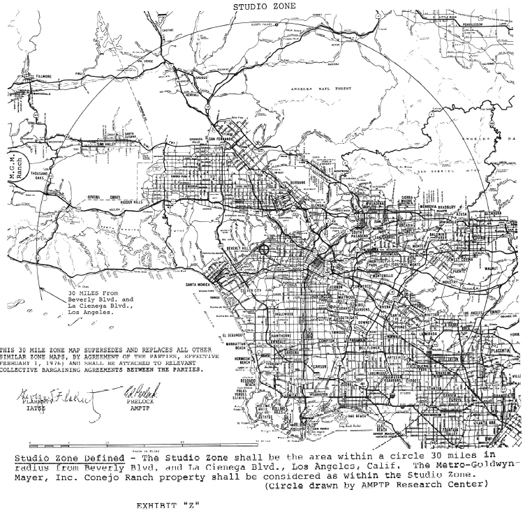
[The Studio Zone, a 30-mile radius in Los Angeles which serves to determine the “rates and work rules for workers in the entertainment industry”; the majority of Los Angeles’ prop houses are located within the Studio Zone; image via the California Film Commission]
Robert Sumrell’s “Story of the Eye: Props”, noted elsewhere:
DPR-Barcelona skip between prop houses, “The Red Violin”, Reynar Banham, and the Smithsons to land on the assertion that today we collect links as immaterial props may be superseding material props:
Consumption has evolved and even it is still outrageous; we are moving to a scenario where services not products are more and more demanded. And in our hybrid cities some kind of immaterial prop houses have emerged to keep our virtual belongings safe. Although Kazys Varnelis pointed that today we collect nothing, we think that today we collect links and information through a del.icio.us or Pearltrees account and also exchange information and services via facebook or twitter. In this sense we are keeping outside our homes a important part of our life. These data are kept safe in servers far away from our physical location and those servers as prop houses provide them a physicality. While having physicality they are exposed to the same kind of “dangers” of our material possessions, they can be lost, damaged by fire, or even stolen.

[The intersection of Beverly Boulevard and La Cienega Boulevard is the exact center of the Studio Zone; image via Wikipedia]
Free Association Design focuses on self-storage facilities, a peculiar and closely-related typology which Sumrell briefly mentions:
The architecture of public storage facilities is as pragmatic and minimal as the retail industry’s big boxes, and both are designed to facilitate a similar and limited prescribed program (maximized cubic footage, climate control, ease of access and security). The linear assembly of roll up doors mimics the retail distribution centers from where most of the objects likely came; only smaller and with a nebulous chain of retail operations, logistical geography, job transfers and other life changes between them. The resemblance sublimely illustrates a conservation of product volume that is distributed across virtually unlimited user space. In the consumer-retailer network, more and larger big boxes beget more big boxes.
Most of the time the extensive footprint of the double-entendred ‘self‘-storage facility is uninhabited by the living. The glorified sheds provide shelter only to inanimate assemblies of stuff and its combined exchange and symbolic value. And just like Hollywood’s prop houses, there is no prescribed order for how the objects within are arranged or what those objects may be. Behind each brightly colored roll-up door (typically the only design flair applied to the architecture) is an eclectic and mysterious collection of cargo that has been amassed via unknown histories.
You’ll want to read on as Brett explains why self-storage facilities are like the remote Pacific Islands that played host to indigenous ‘cargo cults’ in the wake of World War Two.
While “Props” is the last chapter of the Infrastructural City, we did say that we would — and still intend to — post on Varnelis’ Introduction as a means of conclusion. (FASLANYC has already done so.) In the meantime, you should be sure not to miss our interview with Lateral Office.

